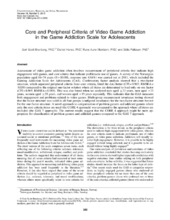| dc.contributor.author | Brunborg, Geir Scott | |
| dc.contributor.author | Hanss, Daniel | |
| dc.contributor.author | Mentzoni, Rune Aune | |
| dc.contributor.author | Pallesen, Ståle | |
| dc.date.accessioned | 2016-03-18T08:57:34Z | |
| dc.date.available | 2016-03-18T08:57:34Z | |
| dc.date.issued | 2015-05 | |
| dc.Published | CyberPsychology, Behavior and Social Networking 2015, 18(5):280-285 | eng |
| dc.identifier.issn | 2152-2723 | |
| dc.identifier.uri | https://hdl.handle.net/1956/11700 | |
| dc.description.abstract | Assessment of video game addiction often involves measurement of peripheral criteria that indicate high engagement with games, and core criteria that indicate problematic use of games. A survey of the Norwegian population aged 16–74 years (N=10,081, response rate 43.6%) was carried out in 2013, which included the Gaming Addiction Scale for Adolescents (GAS). Confirmatory factor analysis showed that a two-factor structure, which separated peripheral criteria from core criteria, fitted the data better (CFI=0.963; RMSEA=0.058) compared to the original one-factor solution where all items are determined to load only on one factor (CFI=0.905, RMSEA=0.089). This was also found when we analyzed men aged ≤33 years, men aged >33 years, women aged ≤33 years, and women aged >33 years separately. This indicates that the GAS measures both engagement and problems related to video games. Multi-group measurement invariance testing showed that the factor structure was valid in all four groups (configural invariance) for the two-factor structure but not for the one-factor structure. A novel approach to categorization of problem gamers and addicted gamers where only the core criteria items are used (the CORE 4 approach) was compared to the approach where all items are included (the GAS 7 approach). The current results suggest that the CORE 4 approach might be more appropriate for classification of problem gamers and addicted gamers compared to the GAS 7 approach. | en_US |
| dc.language.iso | eng | eng |
| dc.publisher | Mary Ann Liebert | eng |
| dc.relation.uri | http://www.ncbi.nlm.nih.gov/pmc/articles/PMC4432774/pdf/cyber.2014.0509.pdf | |
| dc.rights | Attribution CC BY | eng |
| dc.rights.uri | http://creativecommons.org/licenses/by/4.0 | eng |
| dc.title | Core and peripheral criteria of video game addiction in the game addiction scale for adolescents | eng |
| dc.type | Peer reviewed | |
| dc.type | Journal article | |
| dc.date.updated | 2015-12-21T20:06:27Z | |
| dc.description.version | publishedVersion | |
| dc.rights.holder | Copyright 2015 The Authors | eng |
| dc.identifier.doi | https://doi.org/10.1089/cyber.2014.0509 | |
| dc.identifier.cristin | 1225364 | |
| dc.subject.nsi | VDP::Samfunnsvitenskap: 200::Psykologi: 260::Sosial- og arbeidspsykologi: 263 | |
| dc.subject.nsi | VDP::Social sciences: 200::Psychology: 260::Social and occupational psychology: 263 | |

